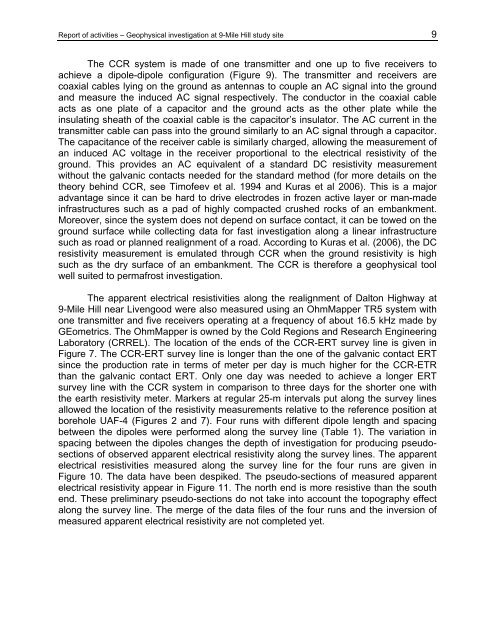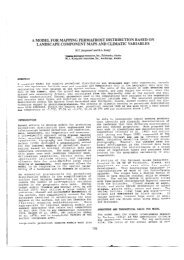Alaska University Transportation Center PROJECT - Institute of ...
Alaska University Transportation Center PROJECT - Institute of ...
Alaska University Transportation Center PROJECT - Institute of ...
Create successful ePaper yourself
Turn your PDF publications into a flip-book with our unique Google optimized e-Paper software.
Report <strong>of</strong> activities – Geophysical investigation at 9-Mile Hill study site 9<br />
The CCR system is made <strong>of</strong> one transmitter and one up to five receivers to<br />
achieve a dipole-dipole configuration (Figure 9). The transmitter and receivers are<br />
coaxial cables lying on the ground as antennas to couple an AC signal into the ground<br />
and measure the induced AC signal respectively. The conductor in the coaxial cable<br />
acts as one plate <strong>of</strong> a capacitor and the ground acts as the other plate while the<br />
insulating sheath <strong>of</strong> the coaxial cable is the capacitor’s insulator. The AC current in the<br />
transmitter cable can pass into the ground similarly to an AC signal through a capacitor.<br />
The capacitance <strong>of</strong> the receiver cable is similarly charged, allowing the measurement <strong>of</strong><br />
an induced AC voltage in the receiver proportional to the electrical resistivity <strong>of</strong> the<br />
ground. This provides an AC equivalent <strong>of</strong> a standard DC resistivity measurement<br />
without the galvanic contacts needed for the standard method (for more details on the<br />
theory behind CCR, see Tim<strong>of</strong>eev et al. 1994 and Kuras et al 2006). This is a major<br />
advantage since it can be hard to drive electrodes in frozen active layer or man-made<br />
infrastructures such as a pad <strong>of</strong> highly compacted crushed rocks <strong>of</strong> an embankment.<br />
Moreover, since the system does not depend on surface contact, it can be towed on the<br />
ground surface while collecting data for fast investigation along a linear infrastructure<br />
such as road or planned realignment <strong>of</strong> a road. According to Kuras et al. (2006), the DC<br />
resistivity measurement is emulated through CCR when the ground resistivity is high<br />
such as the dry surface <strong>of</strong> an embankment. The CCR is therefore a geophysical tool<br />
well suited to permafrost investigation.<br />
The apparent electrical resistivities along the realignment <strong>of</strong> Dalton Highway at<br />
9-Mile Hill near Livengood were also measured using an OhmMapper TR5 system with<br />
one transmitter and five receivers operating at a frequency <strong>of</strong> about 16.5 kHz made by<br />
GEometrics. The OhmMapper is owned by the Cold Regions and Research Engineering<br />
Laboratory (CRREL). The location <strong>of</strong> the ends <strong>of</strong> the CCR-ERT survey line is given in<br />
Figure 7. The CCR-ERT survey line is longer than the one <strong>of</strong> the galvanic contact ERT<br />
since the production rate in terms <strong>of</strong> meter per day is much higher for the CCR-ETR<br />
than the galvanic contact ERT. Only one day was needed to achieve a longer ERT<br />
survey line with the CCR system in comparison to three days for the shorter one with<br />
the earth resistivity meter. Markers at regular 25-m intervals put along the survey lines<br />
allowed the location <strong>of</strong> the resistivity measurements relative to the reference position at<br />
borehole UAF-4 (Figures 2 and 7). Four runs with different dipole length and spacing<br />
between the dipoles were performed along the survey line (Table 1). The variation in<br />
spacing between the dipoles changes the depth <strong>of</strong> investigation for producing pseudosections<br />
<strong>of</strong> observed apparent electrical resistivity along the survey lines. The apparent<br />
electrical resistivities measured along the survey line for the four runs are given in<br />
Figure 10. The data have been despiked. The pseudo-sections <strong>of</strong> measured apparent<br />
electrical resistivity appear in Figure 11. The north end is more resistive than the south<br />
end. These preliminary pseudo-sections do not take into account the topography effect<br />
along the survey line. The merge <strong>of</strong> the data files <strong>of</strong> the four runs and the inversion <strong>of</strong><br />
measured apparent electrical resistivity are not completed yet.




